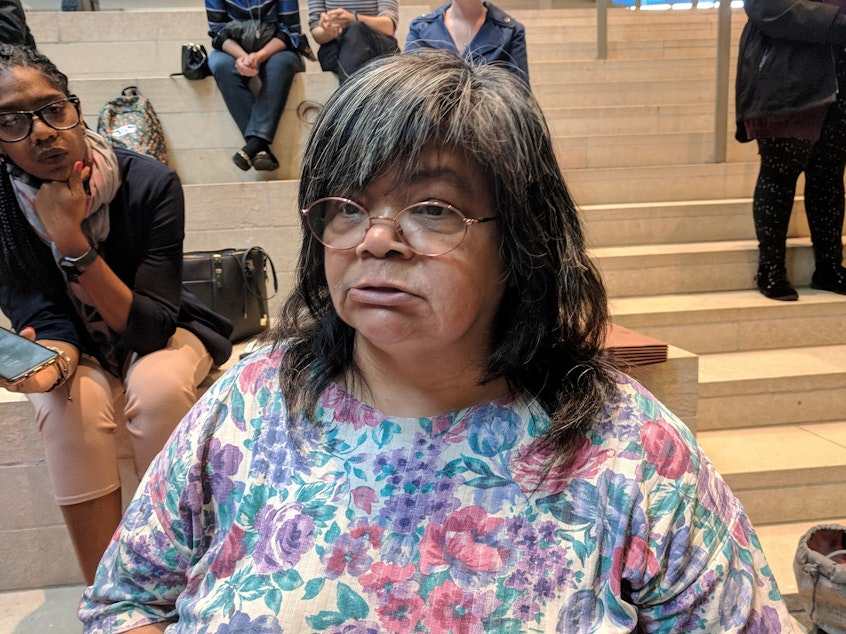People of color are more likely to be evicted in Seattle

Gina Owens was living as a single mom in Seattle when she got into a car crash. The incident knocked her out of the workforce, making it hard to make ends meet.
And then Owens got an eviction notice.
“My daughter and I were evicted into homelessness by the end of that same month,” Owens said at a press conference Thursday.
Owens’ experience was several years ago, but she’s not alone.
The Seattle Women’s Commission and the Housing Justice Project have released a new report looking at evictions in Seattle in 2017. They analyzed more than 1,200 residential eviction cases brought against more than 1,400 tenants within the city limits last year, although the report notes that these records underestimate the number of people who were forced to leave their tenancies in 2017 because many likely don’t go through the formal eviction proceedings.
The report also drew from surveys of 72 tenants seeking services at the Housing Justice Project from March to May 2018.
The report shows more than half the tenants that had evictions filed against them in Seattle in 2017 were people of color. Black tenants saw the greatest disproportionality, experiencing eviction at a rate 4.5 times what would be expected based on Seattle’s demographics.
Tana Yasu, a member of the Seattle Women’s Commission, said seeing the rate at which black Seattleites are evicted doesn’t speak of progress or progressive policies to her.
“Seattle boasts inclusion and is as far away from inclusion as we are from the sun – light years,” she said. “I was proud of my city. I was proud until I peeked behind the veil and began to see the truth.”
When it comes to why people face eviction, the overwhelming majority of filings were over unpaid rent. This is unsurprising, with roughly 45 percent of renter households in the Seattle metro area living cost-burdened.
But the level of outstanding rent that triggered eviction filings weren’t as high as some might expect. Half the cases were filed when tenants owed one month or less. Three quarters of cases over unpaid rent were initiated over less than $2,500. One case sought just $10 in outstanding rent, according to the report authors.
The report also shows that women were far more likely to be evicted for owing small amounts of money.
The majority of people surveyed said loss of employment or income was what caused them to fall behind on rent.
"One emergency, one missed paycheck, one family tragedy means the difference between living in a home and becoming homeless on the streets," Gina Owens said.
And tenants can come out of eviction proceedings owing more than the rent that sent them there in the first place. The report states that in more than 90 percent of cases, legal and court fees fell to the tenants.
“In total, compared to the median rent owed by tenants in all nonpayment of rent actions, the amount of attorney’s costs and fees increased the amount owed to the landlord by about one-third,” the report states.
The authors argue that eviction has multiple negative impacts, including financial impacts, health impacts and long term impacts on kids.
Owens said she became homelessness after she was evicted. According to the report, that’s not uncommon. Nearly 90 percent of survey respondents said they became homeless after an eviction.
Three quarters of eviction filings in 2017 ended in tenants leaving their homes, but “only 12.5 percent of evicted respondents found another apartment or home to move into. Ultimately, eviction pushed low-income tenants out of Seattle: 43.5 percent of evicted respondents had to leave the city as a result,” according to the report.
It also draws connections between evictions and gentrification in certain parts of Seattle. The report looks at eviction cases by zip code and, while it notes that evictions occur across the city, it also states:
“Nearly half of all cases (43.1 percent) were in zip codes where the white population increased from 2011 to 2016. Similarly, the overwhelming majority (95.8 percent) of eviction filings occurred in zip codes in which the median household income (adjusted for inflation) increased between 2011 and 2016.”
So what are the solutions?
As always, more affordable housing is raised as a key need. The authors make several other policy recommendations as well, including requiring landlords to offer payment plans and increasing the amount of time a tenant has to address outstanding rent.
They also suggest things like expanding the ability for tenants to take on roommates to help afford rent.
Kamaria Hightower, a spokesperson for Seattle Mayor Jenny Durkan’s office, said in a statement that the report confirms the experience of eviction can have long lasting and devastating consequences.
“Evictions destabilize lives, uproot families and can push our most vulnerable into homelessness. The City of Seattle is committed to doing everything possible to increase affordability, stability and economic security for our residents,” Hightower said.




